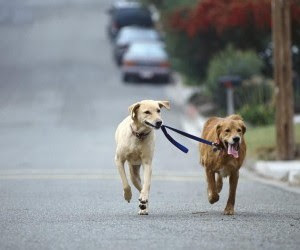1. Spay or neuter
Spaying, or removing the ovaries and uterus of a female dog, stops a female dog from going into heat and can help prevent breast cancer and pyometra, or infection of the uterus. Neutering, or removing the testicles of a male dog, can mellow out aggressive conduct, and help prevent testicular cancer, prostate disease, and hernias.
2. Vaccinate
By three months of age, the protective antibodies naturally passed along through a mother's milk have been used up and a puppy needs a five-in-one vaccine to help protect it against many common infectious diseases, including leptospirosis, distemper and parvovirus, as well as a rabies vaccination. Your vet may also recommend vaccinations for kennel cough and Lyme disease.
3. Visit your vet
Like you, dogs need regular visits to the doctor to ensure good health. An annual health check gives your vet the chance to nip any illness or health concerns in the bud before they can cause big problems and bills. The vet will ask about your pet's behavior, eating, and exercise habits, while checking your dog's vital stats.
4. Declare war on fleas
Fleas can cause health problems beyond itchy skin. They can be the source of allergies, anemia, and tapeworms. Fortunately there are a myriad of flea control products available, including Advantage and Frontline, two of the most popular. Monthly applications should be given based on the weight of your dog. Keep in mind when you are gearing up for your flea wars you must treat all your pets, not just the ones where fleas are obvious.
5. Treat heartworm by preventing it
Heartworm is very difficult to treat and can be fatal for your dog, so prevention is the key. Giving your dog one dose monthly of a tablet, like Heartguard, can stop heartworm before it starts.
6. Exercise your dog every day
And not just a quick jaunt around the block. Exercise through walking and playing with your dog will keep him physically fit and mentally healthy, and reduce the chance of belligerent and destructive behavior, too. Regular exercise also helps your dog maintain a healthy weight and heart, while increasing muscle mass. Your dog's exercise requirements will be different depending on breed, sex, age, and health.
7. Watch his weight
Lack of exercise and overfeeding is as much a problem in pets as it is in people. Your dog cannot decide how much exercise he needs or what kind of food he should eat; only you can do that. Arthritis, liver disease, and coronary disease are just a few of the health issues facing an overweight dog. To help your dog lose weight, your vet may recommend a mix of exercise and switching to a low-calorie brand of food, or gradually reducing the amount of regular food by 10 to 25 percent.
8. Weekly health checks
One of the best ways to prevent health issues is to check up on your dog weekly. First, inspect your dog's coat and skin for swelling, flakes or scabs. Then look into your dog's ears and eyes for any signs of redness or discharge. Finally watch for any changes in eating or drinking habits. If anything differs from what's normal for your dog, consult your vet.
9. Stay away from dangerous foods
The ASPCA Animal Poison Control Center compiled a list of foods that could be dangerous, even poisonous for your dog: alcoholic beverages, chocolate, avocado, coffee, fatty foods, macadamia nuts, spoiled or moldy foods, onions and onion powder, grapes and raisins, salt, garlic, yeast dough, and products sweetened with xylitol. Post this list and be sure your family and any caregivers are aware of it.
10. Brush his teeth!
Bad breath can be a sign of teeth or gum problems. Particles of food, saliva, and bacteria known as plaque can build up on the gums and teeth and cause infection. If you don't treat this, infection can result in tooth decay and even move into the bloodstream and affect your pet's heart, lungs, liver, kidneys, bones, and joints. Inspect teeth and gums weekly, and check with your vet for instructions on regular brushing with canine toothpaste.
Source: Adapted from the ASPCA














